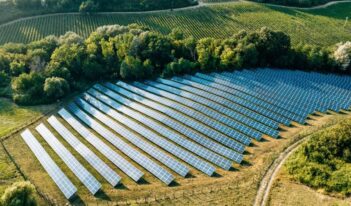
Scholar asserts that federal law and incentive structures should facilitate renewable energy development on tribal lands.
Tribal lands in the United States have the potential to generate enough wind and solar energy to supply the needs of the entire country. But this tremendous clean energy capacity remains almost completely untapped. In a recent paper, energy attorney Michael Maruca urges federal and state governments to take steps that would unlock this great potential for renewable energy production.
Large-scale renewable energy projects on tribal reservations benefit all parties involved, Maruca argues. These projects serve the nation, states, and tribal governments in combatting climate change, increasing energy independence, and protecting national security.
But tribes also reap their own benefits from large-scale renewable projects. Clean energy development enhances tribal economies, creates sustainable jobs, expands tribal nations’ economic base, and combats indigenous exploitation by encouraging tribal self-determination. In contrast to the exploitative history of fossil fuel extraction on tribal lands, renewable energy projects promise tribes a safe, environmentally sustainable way to boost tribes’ economic prospects.
For over a decade, scholars have been writing about tribal lands’ exceptional renewable energy potential, but few tribes have started large-scale renewable projects. Maruca investigates three successful large-scale renewable projects: the Campo Kumeyaay Nation’s Kumeyaay Wind Farm along California’s border with Mexico, the Moapa Band of Paiutes’ Moapa Solar Project in southern Nevada, and the Navajo Nation’s Kayenta Solar Project in northeastern Arizona. Recognizing that these projects present tribal governments with major regulatory and financial obstacles, Maruca proposes four solutions to encourage greater development.
First, Congress should reform federal law to facilitate tribal ownership of clean energy facilities on reservation land. While Congress passed a 2005 law enabling tribal ownership of wind and solar farms on reservation land, the law imposes high costs and extensive environmental regulation on tribes. In 14 years, the law has yet to be used to structure a clean energy facility ownership agreement on tribal land.
The impracticality of solar or wind farm ownership drives tribes to lease their land to energy developers who build the projects themselves and reap most of the associated benefits. Clean energy project profits are thus limited to the value of lease payments, and the developer—who typically also secures project funding—gets both the tax credits and the project royalties. That third parties—rather than tribal governments—reap most of the benefits of developing projects on reservation land has a dampening effect on tribal governments looking for investments.
The requirement of partnering with non-tribal developers also presents a barrier, given the history of tribal exploitation in energy extraction and consequent mistrust between tribal governments and non-tribal partners. Maruca notes that successful and carefully planned projects have the power to encourage subsequent partnership, but that the relationship-building process takes time.
Maruca concludes that legal reform facilitating energy project ownership would remove the current need to lease to third parties. Project ownership would provide tribes with the full return on investment without which it is hard to justify the costs of clean energy installation. He also notes that the ownership model is more faithful to the federal government’s goal of encouraging tribal self-determination, particularly in managing infrastructure on reservation land.
Second, Congress and the U.S. Department of Energy must expand federal financial incentives to include tribal-specific programs. The fact that federal incentives for renewable development currently take the form of tax credits is arguably the largest barrier to tribal investment in large-scale clean energy. Tribes do not pay federal taxes, and thus do not benefit from the credits that encourage much of the investment from private and public developers.
The federal government, Maruca argues, should also expand the scale and nature of financing opportunities available to tribes. Current federal financing opportunities—primarily taking the form of loans and subsidies—are limited, and not all are available to tribes. The Energy Department, he concludes, should implement financing models specifically engineered to meet tribal needs.
Third, Congress should bar state taxation of energy facilities on tribal lands. Despite the fact that tribes continue to lease their lands to third-party energy developers and thus see fewer benefits than other investors, tribes still have to pay state and county taxes that are levied on energy installations. This additional expense only further discourages large-scale tribal wind and solar development, and it may make such development financially infeasible.
Finally, Congress must streamline electricity regulation to minimize barriers to new investors in the regulatory energy market. The complex regulatory patchwork of federal and state laws governing the production and sale of electricity dissuades new entrants to the market who lack industry expertise and who may not have a seat at the table when state governments set policy for the transmission and sale of electricity.
Tribal nations and their non-tribal neighbors would benefit from the clean energy production facilitated by Maruca’s proposed regulatory and policy changes.



